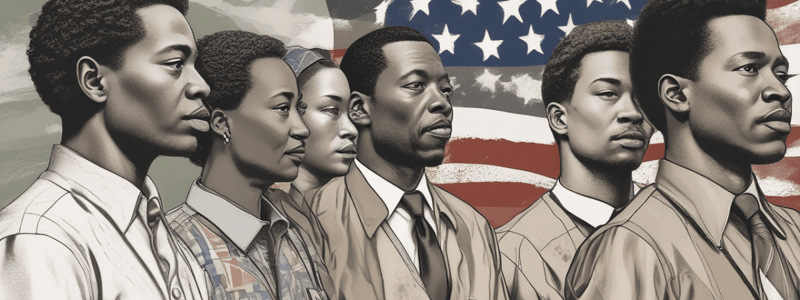Podcast
Questions and Answers
What was the outcome of the Brown vs. Board of Education of Topeka case in 1954?
What was the outcome of the Brown vs. Board of Education of Topeka case in 1954?
- Segregation in schools was deemed constitutional
- The Supreme Court ruled that segregation in schools was unconstitutional (correct)
- The decision was postponed indefinitely
- The case was dismissed due to lack of evidence
What was the main goal of the Freedom Rides in 1961?
What was the main goal of the Freedom Rides in 1961?
- To end segregation on buses and trains in the South (correct)
- To organize sit-ins at lunch counters
- To boycott businesses that practiced segregation
- To register African Americans to vote
Who was the 14-year-old African American boy whose murder in 1955 sparked widespread outrage and helped galvanize the Civil Rights Movement?
Who was the 14-year-old African American boy whose murder in 1955 sparked widespread outrage and helped galvanize the Civil Rights Movement?
- Medgar Evers
- Martin Luther King Jr.
- Jimmie Lee Jackson
- Emmett Till (correct)
What was the significance of the 14th Amendment to the Civil Rights Movement?
What was the significance of the 14th Amendment to the Civil Rights Movement?
What was the primary goal of the Southern Christian Leadership Conference (SCLC)?
What was the primary goal of the Southern Christian Leadership Conference (SCLC)?
Flashcards are hidden until you start studying
Study Notes
Civil Rights Movement: Key Events and Figures
- Emmet Till: A 14-year-old black boy brutally murdered in Mississippi in 1955 for allegedly flirting with a white woman, sparking national outrage and fueling the Civil Rights Movement.
Montgomery Bus Boycott
- December 1, 1955: Rosa Parks, a black seamstress, refused to give up her seat to a white person on a Montgomery, Alabama bus, sparking the Montgomery Bus Boycott.
- Led by Dr. Martin Luther King Jr.: The boycott lasted 381 days, ending with the U.S. Supreme Court ruling that segregation on public buses was unconstitutional.
Lunch Counter Sit-ins
- February 1, 1960: Four African American college students staged a sit-in at a segregated lunch counter in Greensboro, North Carolina, inspiring similar protests across the South.
- Nonviolent resistance: The sit-ins employed nonviolent resistance, popularized by Dr. Martin Luther King Jr., to challenge segregation and discrimination.
Freedom Rides
- May 1961: Interracial groups of activists rode buses through the South, testing the enforcement of Supreme Court decisions banning segregation in interstate transportation.
- Violence and arrests: The Freedom Rides faced violent opposition, resulting in arrests and national attention.
Letter from Birmingham Jail
- April 16, 1963: Dr. Martin Luther King Jr. wrote the Letter from Birmingham Jail, a powerful call to action for civil rights, while imprisoned for participating in nonviolent protests.
Voting Registration Drives
- 1960s: Civil rights activists, including the Student Nonviolent Coordinating Committee (SNCC), launched voting registration drives to increase African American political participation.
Murder of Civil Rights Workers in Philadelphia
- June 21, 1964: Three civil rights workers, James Chaney, Andrew Goodman, and Michael Schwerner, were murdered in Philadelphia, Mississippi, while participating in the Freedom Summer project.
Jimmie Jackson
- February 18, 1965: Jimmie Jackson, a 26-year-old African American, was fatally shot by a state trooper during a civil rights protest in Marion, Alabama.
Bloody Sunday
- March 7, 1965: State troopers and local police violently attacked peaceful civil rights marchers in Selma, Alabama, on Bloody Sunday, prompting national outrage.
Bombing of the 16th Street Church
- September 15, 1963: The 16th Street Baptist Church in Birmingham, Alabama, was bombed, killing four young African American girls and injuring 22 others.
Little Rock 9
- September 1957: Nine African American students, known as the Little Rock 9, integrated Little Rock Central High School in Arkansas, facing violent protests and opposition.
The Southern Christian Leadership Conference (SCLC)
- Founded in 1957: The SCLC was a civil rights organization led by Dr. Martin Luther King Jr., focusing on nonviolent resistance and civil rights activism.
Integration and Segregation
- Integration: The process of ending racial segregation and discrimination, ensuring equal access to education, employment, and public facilities.
- Segregation: The practice of separating people based on race, enforced by laws and social norms in the United States until the mid-1960s.
Brown vs. Board of Education of Topeka
- 1954: The U.S. Supreme Court ruled that segregation in public education was unconstitutional, paving the way for the Civil Rights Movement.
Housing Segregation
- Racial segregation: The practice of separating people based on race, often enforced through discriminatory housing policies and zoning laws.
Grievances of Blacks
- Racial discrimination: African Americans faced discrimination in employment, education, housing, and voting, leading to widespread grievances and demands for civil rights.
The 14th Amendment
- 1868: The 14th Amendment to the U.S. Constitution granted citizenship and equal protection under the law to former slaves, later used to argue for civil rights protections.
What are Civil Rights?
- Basic rights: Civil rights are the fundamental rights and freedoms of individuals, including the right to equality, justice, and participation in the political process.
Studying That Suits You
Use AI to generate personalized quizzes and flashcards to suit your learning preferences.




